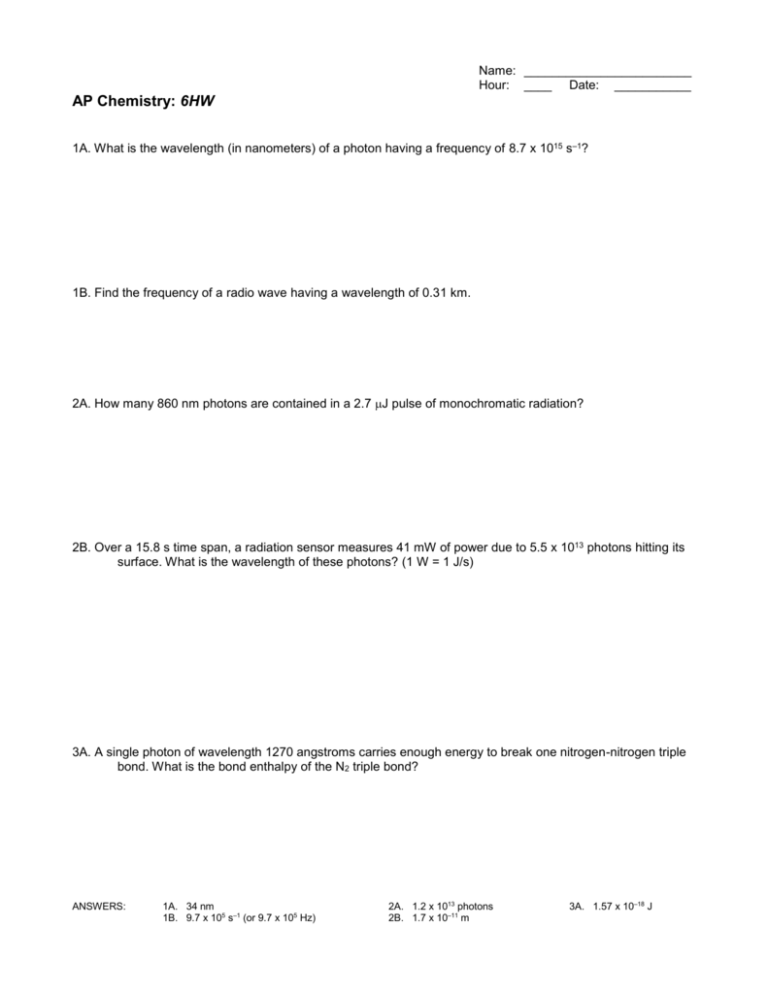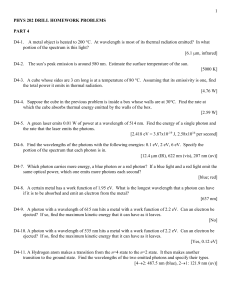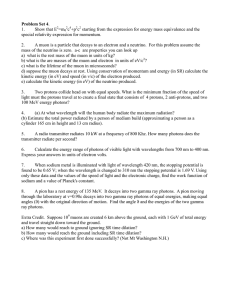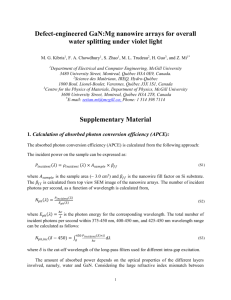Homework - Teach.Chem
advertisement

Name: ________________________ Hour: ____ Date: ___________ AP Chemistry: 6HW 1A. What is the wavelength (in nanometers) of a photon having a frequency of 8.7 x 1015 s–1? 1B. Find the frequency of a radio wave having a wavelength of 0.31 km. 2A. How many 860 nm photons are contained in a 2.7 J pulse of monochromatic radiation? 2B. Over a 15.8 s time span, a radiation sensor measures 41 mW of power due to 5.5 x 1013 photons hitting its surface. What is the wavelength of these photons? (1 W = 1 J/s) 3A. A single photon of wavelength 1270 angstroms carries enough energy to break one nitrogen-nitrogen triple bond. What is the bond enthalpy of the N2 triple bond? ANSWERS: 1A. 34 nm 1B. 9.7 x 105 s–1 (or 9.7 x 105 Hz) 2A. 1.2 x 1013 photons 2B. 1.7 x 10–11 m 3A. 1.57 x 10–18 J 3B. Carbon-oxygen double bonds have a bond enthalpy of 782 kJ/mol. How many photons of wavelength 7.8 m are required to break a single C=O bond? 4A. In the photoelectric effect, the energy needed to knock an electron out from a metal’s surface is called the work function. Zinc has a work function of 4.3 eV (electron-volts). A photon having what maximum wavelength is required to eject an electron from the surface of zinc? (1 eV = 1.6 x 10–19 J) 4B. Cesium has a work function of 2.1 eV. If a photon of wavelength 8.6 x 10–8 m is absorbed by an electron in a cesium atom, with what kinetic energy will the electron be ejected? 5A. How much energy must be absorbed for an electron in a hydrogen atom to jump from the third to the sixth energy level? 5B. How much energy (in kJ/mol) must be absorbed to eject n = 1 electrons from a hydrogen atom? ANSWERS: 3B. 51 photons 4A. 2.9 x 10–7 m 4B. 2.0 x 10–18 J 5A. 1.82 x 10–19 J 5B. 1,300 kJ/mol 6A. A photon of what frequency is emitted from a hydrogen atom when an electron falls from n = 4 to n = 1? 6B. A 1.28 micron photon is emitted when an electron in a hydrogen atom falls from n = 5 to n = ? 7A. What is the de Broglie wavelength for a fluorine molecule moving at 320 m/s? 7B. A muon is a subatomic particle having 11.3% of the mass of a proton. Calculate the de Broglie wavelength (in angstroms) for a muon traveling at 6.18 x 104 km/h. ANSWERS: 6A. 3.1 x 1015 Hz (or 3.1 x 1015 s–1) 6B. n = 3 7A. 3.3 x 10–11 m 7B. 2.06 angstroms 8A. What is the uncertainty in the position of a neutron moving at a speed of (6.00 +/– 0.01) x 104 m/s? 8B. What is the uncertainty in the position of an electron moving at a speed of (8.50 +/– 0.01) x 107 m/s? It takes about 1836 electrons to equal the mass of a single proton. 9. Give the values of n, l, and m for each orbital in the 4d subshell. Write condensed electron configurations for each of the following. 10A. Ge 10B. Ag+ Ba Fe2+ Ag Cu2+ ANSWERS: 8A. 3 x 10–10 m 8B. 6 x 10–10 m 11A. Suppose that a microwave oven heats food by emitting photons of wavelength 12.6 cm. About how many photons must be absorbed by 250 mL of coffee to heat it from 20.oC to 78oC? 11B. A 950 g sample of 22oC water is placed outside on a winter night. To freeze completely solid, the water must emit the energy equivalent of HOW MANY infrared photons of wavelength 8.75 x 10–4 m? ANSWERS: 11A. 3.8 x 1028 photons 11B. 1.8 x 1027 photons











